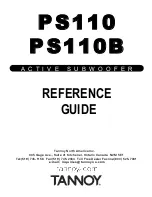
7
TRUTH B2092A
3. APPLICATIONS
Connect the mixing console outputs to the B2092A inputs marked
LEFT and RIGHT
. If you are using active monitors as main
loudspeakers (e.g. B2030A or B2031A), connect the left
loudspeaker to LEFT OUT, and connect the right loudspeaker to
RIGHT OUT. If using passive loudspeakers, connect LEFT OUT
and RIGHT OUT connectors to the power amplifier inputs.
The B2092A separates the bass segment of the audio signal for
the subwoofer and sends all frequencies above the 80-Hz mark
to the outputs for the main loudspeakers.
3.1.2 Multichannel surround setup
Fig. 3.2: Wiring example for a surround system
Surround system with a decoder:
If you want to integrate the B2092A into a 5.1 loudspeaker system
that is coupled to a surround decoder (DTS
®
or
Dolby Digital
®
), connect the decoder LFE output to the SUB input
on your B2092A. The signals of a LFE channel (LFE = Low
Frequency Effect or Low Frequency Enhanced) may contain
frequencies of up to 120 Hz. However, since the B2092A does
not reproduce signals above the 80-Hz mark, the LFE signals are
passed onto the CENTER output and are then reproduced on the
center loudspeaker. This way, these important signal segments
are not lost. This is of particularly high value when using the
B2092A as a studio monitor, because this way undesirable noise
and distortion in this frequency range can be kept under control.
Wire the remaining active loudspeakers as shown in the
illustration.
Surround system without decoder:
You can create a surround system even without using a surround
decoder, for example as a multichannel monitor system at your
sound studio or for specific surround installations. The surround
channels are reproduced using a single output of a mixing
console, a surround monitor controller or using the separately
recorded channels of a multitrack recorder.
Connect the output of the front left channel to the LEFT IN
connector on the B2092A; connect the output of the front right
channel to the RIGHT IN connector. Connect the center channel
output to CENTER IN. If the surround mix has no separate
subwoofer channel, the signal for this channel is created using
the bass segments of the left, center and right channels.
Now, connect the left (active) front loudspeaker to LEFT OUT.
Connect CENTER OUT to the center speaker and RIGHT OUT to
the right speaker. All additional surround speakers (Left Surround
= LS, Right Surround = RS) are connected directly to the
corresponding outputs on your system.
If you wish to use passive loudspeakers, connect the individual
surround channels of your system to the power amp inputs of
the corresponding surround speakers.
3.2 Input signal level adjustment
If the loudspeaker system is correctly wired and powered on,
you can bring up the control room output of your mixing console
or the volume controls of your decoder. If a signal source is
connected, you can hear your B2092A for the first time. To
obtain well-balanced sound, you only have to adjust the input
sensitivity of your subwoofer. The default INPUT TRIM control
setting is 0 dB. To adjust the signal level to the main speakers,
values from -6 dB to +6 dB can be selected using this control.
LIMIT LED
lights up as soon as one of the internal overload
circuits springs into action. By the way, no damage is caused to
your B2092A if the LIMIT LED briefly lights up during operation
(when signal peaks occur). However, you should try to avoid
the LIMIT LED lighting up for prolonged periods of time (in that
case, after a while the thermal fuse is activated, and the internal
power amplifier is switched off for a while). This is a sure sign
that your B2092A is overloading. Lower the input signal level
either on your mixing console or by using the INPUT TRIM control.
+
The B2092A is capable of producing high volume
levels. You should mix your recordings at moderate
levels to avoid listening fatigue and hearing
impairment.
3.3 Correct placement
Bass frequencies, due to their long wavelengths and undirected
(spherical) dispersion pattern, can not be physically located as
a sound source. Many people take this to mean that you can
place the subwoofer wherever you want. However, this is not
true. Placement of the subwoofer in a room has an important
influence on the overall loudspeaker sound. Even minor changes
in the placement of the subwoofer can make a big difference.
Each room has its own sonic characteristics, which differ based
on room volume and the length ratio of the walls to the ceiling.
Even the material and the composition of surfaces play a big
role. Specific acoustic characteristic result from these influences,
and they must be taken into consideration.
Certain frequencies sometimes create stationary waves
between parallel room walls. The frequencies of these stationary
walls correspond to the rooms resonance, and are determined
by the rooms dimensions. If the room resonance is influenced
by the subwoofer, this frequency gets especially loud in certain
places in the room, while it cannot be heard at all in othersthis
is caused by stationary increases and cancellations. This
phenomenon is especially pronounced with low frequencies,
and can be rather unpleasant. We recommend first finding the
position in which the subwoofer achieves the best results without




























